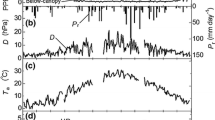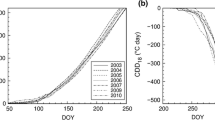Abstract
Within the same forest, photosynthesis can vary greatly among species and within an individual tree. Quantifying the magnitude of variation in leaf-level photosynthesis in a forest canopy will improve our understanding of and ability to model forest carbon cycling. This information requires extensive sampling of photosynthesis in the canopy. We used a 22-m-tall, four-wheel-drive aerial lift to reach five to ten leaves from the tops of numerous individuals of several species of temperate deciduous trees in central Massachusetts. The goals of this study were to measure light-saturated photosynthesis in co-occurring canopy tree species under field conditions, and to identify sampling schemes appropriate for canopy tree studies with challenging logistics. Photosynthesis differed significantly among species. Even though all leaves measured were canopy-top, sun-acclimated foliage, the more shade-tolerant species tended to have lower light-saturated photosynthetic rates (P max) than the shade-intolerant species. Likewise, leaf mass per area (LMA) and nitrogen content (N) varied significantly between species. With only one exception, the shade-tolerant species tended to have lower nitrogen content on an area basis than the intolerant species, although the LMA did not differ systematically between these ecological types. Light-saturated P max rates and nitrogen content, both calculated on either an area or a mass basis, and the leaf mass to area ratio, significantly differed not only among species, but also among individuals within species (P<0.0001 for both). Differences among species accounted for a greater proportion of variance in the P max rates and the nitrogen content than the differences among individuals within a species (58.5–78.8% of the total variance for the measured parameters was attributed to species-level differences versus 5.5–17.4% of the variance was attributed to differences between individual trees of a given species). Furthermore, more variation is accounted for by differences among leaves in a single individual tree, than by differences among individual trees of a given species (10.7–30.4% versus 5.5–17.4%). This result allows us to compare species-level photosynthesis, even if the sample size of the number of trees is low. This is important because studies of canopy-level photosynthesis are often limited by the difficulty of canopy access. As an alternative to direct canopy access measurements of photosynthesis, it would be useful to find an ”easy-to-measure” proxy for light-saturated photosynthetic rates to facilitate modeling forest carbon cycling. Across all species in this study, the strongest correlation was between nitrogen content expressed on an area basis (mmol m–2, N area) and light-saturated P max rate (μmol m–2 s–1, P maxarea) (r 2=0.511). However, within a given species, leaf nitrogen was not tightly correlated with photosynthesis. Our sampling design minimized intra-specific leaf-level variation (i.e., leaves were taken only from the top of the canopy and at only one point in the season). This implies that easy-to-measure trends in nitrogen content of leaves may be used to predict the species-specific light-saturated P max rates.
Similar content being viewed by others

Author information
Authors and Affiliations
Additional information
Received: 16 March 1996 / Accepted: 16 August 1996
Rights and permissions
About this article
Cite this article
Bassow, S., Bazzaz, F. Intra- and inter-specific variation in canopy photosynthesis in a mixed deciduous forest. Oecologia 109, 507–515 (1997). https://doi.org/10.1007/s004420050111
Issue Date:
DOI: https://doi.org/10.1007/s004420050111



